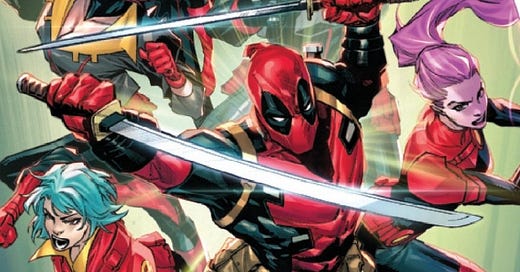Writer: Geoffrey Thorne
Art: Marcus To
Colors: Erick Arciniega
Letters: VC’s Joe Caramagna
Cover: Stephen Segovia & Bryan Valenza
Variant Covers: Chris Allen & GURU-eFX; Mahmud Asrar & Matthew Wilson; Clayton Crain; Tony Daniel & Marcelo Maiolo; David Nakayama; Skottie Young
Publisher: Marvel Comics
Price: 4.99
Release Date: July 31, 2024
Substack Exclusive
The Old Versus The New
The X-Force label returns for a brand new series with a completely different mission. The newest From the Ashes entry looks to separate itself from the prior two Earthbound series. Like the previous first issues, X-Force #1 swings for the fences.
The world is in danger of fracturing and breaking apart, and Forge means to stop it. X-Force #1 catches up with him as he uses Hank McCoy’s old research to increase his own power. From there he goes about recruiting a team: Sage, Askani, and Captain Britain. Under Forge’s direction, this new X-Force combats creatures defending the first fracture.
Sage and Forge make an intriguing pair of leaders for the new X-Force. They each have very unconventional knowledge based powers. But before the characters get to that point, Sage has to be rehabilitated from an apparent psychotic break. Sage’s condition is introduced and solved in the space of a page and a half in X-Force #1. It’s worth noting that in the previous X-Force run, Sage’s internal conflicts led her to have a drinking problem that spiraled out of control. Percy went so far as to write Sage referring to herself as an alcoholic.
That Sage is an alcoholic doesn’t mean that stress automatically causes her to relapse. But that history, combined with obvious mental trauma and her past experiences during the previous X-Force run, makes her recovery over the course of a five panel conversation seem dubious at best. To the extent that character arcs over the course of the Krakoa era matter in the From the Ashes era (it’s arguable that writers are discarding them when convenient), Thorne’s version of Sage reads as vastly different from Percy’s.
Setting aside any questions about Sage’s long-term characterization, as presented in X-Force #1 she works well. Putting her in the narrator position puts distance between Forge and the reader, and it is surprisingly effective. Forge becomes a mysterious figure–which in some respects he always has been. While what he does is easily explained, how he does it is more vague. Thorne uses Sage, who is trying to understand him herself, as a means to explain Forge’s ability and purpose to the reader. Furthermore, someone else conveying Forge’s strength is more convincing than Forge basically bragging in his own internal monologue.
With X-Force #1, From the Ashes rolls out the first X series that is on Earth but seemingly uninterested in mutant and human affairs. Forge’s very single minded goal is to keep the world from breaking apart, and he doesn’t seem to care what he has to do to accomplish that. Thorne doesn’t put much time into the team building background, but what little there is suggests everyone is onboard with that same clear mission. As was the case with Phoenix, it’s compelling to have a series largely divorced from typical human/mutant storylines. But unlike Phoenix, including existing characters for the team is a welcome decision.
The inclusion of Betsy and Rachel on the team creates the potential for more than just standard team dynamics. Will they stay together forever? Will there be romantic tension? Will their relationship interfere with how they function with their teammates?
Youth And Uniforms
Character designs for the new X-Force team are an effective blend of updated individual features and uniformity. Identical uniforms fit with the idea of Forge’s single minded purpose.
X-Force #1 opens with a splash page featuring a large team of X-Men battling the Brood in front of a cityscape. It’s an impressive start to the issue–action packed and full of detail. Thorne writes a compelling opening sequence, and this first page will grab readers immediately. But that owes entirely to To’s art.
To’s style for character features tends toward a minimum of lines and shading. He uses just enough of each to contour facial features–primarily cheekbones. In a general sense, the characters’ features are particularly soft. Without lines around eyes and mouths, everyone looks on the young side–especially compared to Forge. He’s the one character that To consistently adds extra detail to. It creates a definite separation in age between him and everyone else.
Arciniega tends toward a vivid color palette. But especially bright is any form of energy, whether offensive in a fight or in a more benign moment such as when Forge powers up early in the issue. The color choices provide effective contrast in almost all action sequences. The one exception is the detailed splash page that opens the issue. To’s art stands out, but the color palette is darker and less varied.
Caramagna’s choice of background color for Sage’s narration is particularly effective. The light blue is distinct among every background in the issue. It stands out without being obtrusive, and the black text is still easy to read.
Final Thoughts
Sage’s questionable characterization is the chief problem here. It ultimately doesn’t detract from the story and only matters in terms of continuity from the Krakoa era. That aside, the story largely works. The art team delivers high quality work as well. X-Factor #1 is a strong first issue with a premise and character set that offers a lot of potential.
What is good, everybody?
Thanks for reading the review of Marvel Comics’ X-Force #1.
If you enjoyed this review (or even hated it!)…
And if you enjoy what you find here and would like to provide a little extra support…
You can also find me on Twitter and Bluesky where I’m very active.




